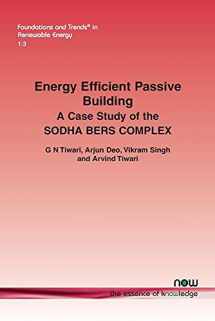
Energy Efficient Passive Building: A case study of the SODHA BERS COMPLEX (Foundations and Trends(r) in Renewable Energy)
ISBN-13:
9781680831962
ISBN-10:
1680831968
Author:
Vikram Singh, G. N. Tiwari, Arjun Deo
Publication date:
2016
Publisher:
Now Publishers
Format:
Paperback
94 pages
FREE US shipping
Book details
ISBN-13:
9781680831962
ISBN-10:
1680831968
Author:
Vikram Singh, G. N. Tiwari, Arjun Deo
Publication date:
2016
Publisher:
Now Publishers
Format:
Paperback
94 pages
Summary
Energy Efficient Passive Building: A case study of the SODHA BERS COMPLEX (Foundations and Trends(r) in Renewable Energy) (ISBN-13: 9781680831962 and ISBN-10: 1680831968), written by authors
Vikram Singh, G. N. Tiwari, Arjun Deo, was published by Now Publishers in 2016.
With an overall rating of 4.1 stars, it's a notable title among other
books. You can easily purchase or rent Energy Efficient Passive Building: A case study of the SODHA BERS COMPLEX (Foundations and Trends(r) in Renewable Energy) (Paperback) from BooksRun,
along with many other new and used
books
and textbooks.
And, if you're looking to sell your copy, our current buyback offer is $0.49.
Description
This monograph focuses on a case study of a newly constructed passive cooled four-story building in a composite climate. The building at the heart of the case study is known as SODHA BERS COMPLEX (SBC) and is situated in Varanasi, India. In the design of the SBC building, most traditional cooling concepts like orientation, cross ventilation, day lighting, unglazed Trombe wall, earth sheltering, wind towers, and so on, were incorporated. Furthermore, a solar water heating system, roof top PV system and photovoltaic thermal greenhouse dryer were integrated to meet the energy demand of the building. The total initial embodied energy, CO₂ emissions, annual energy saving and CO2 credit of the SBC were evaluated as part of the case study. Based on these evaluations, it was observed that during harsh summer and cold climatic conditions, the earth sheltering/basement ( 28 ) and first and second floors ( 18 ) are the most comfortable areas from a passive cooling/heating point of view respectively. In addition, it was observed that there are about 4740 tons of earned CO2 credit with (i) a payback period of 20 years and (ii) a unit of energy saving of 3kWh for an average 10 temperature difference between room and ambient air temperature.


We would LOVE it if you could help us and other readers by reviewing the book
Book review

Congratulations! We have received your book review.
{user}
{createdAt}
by {truncated_author}


